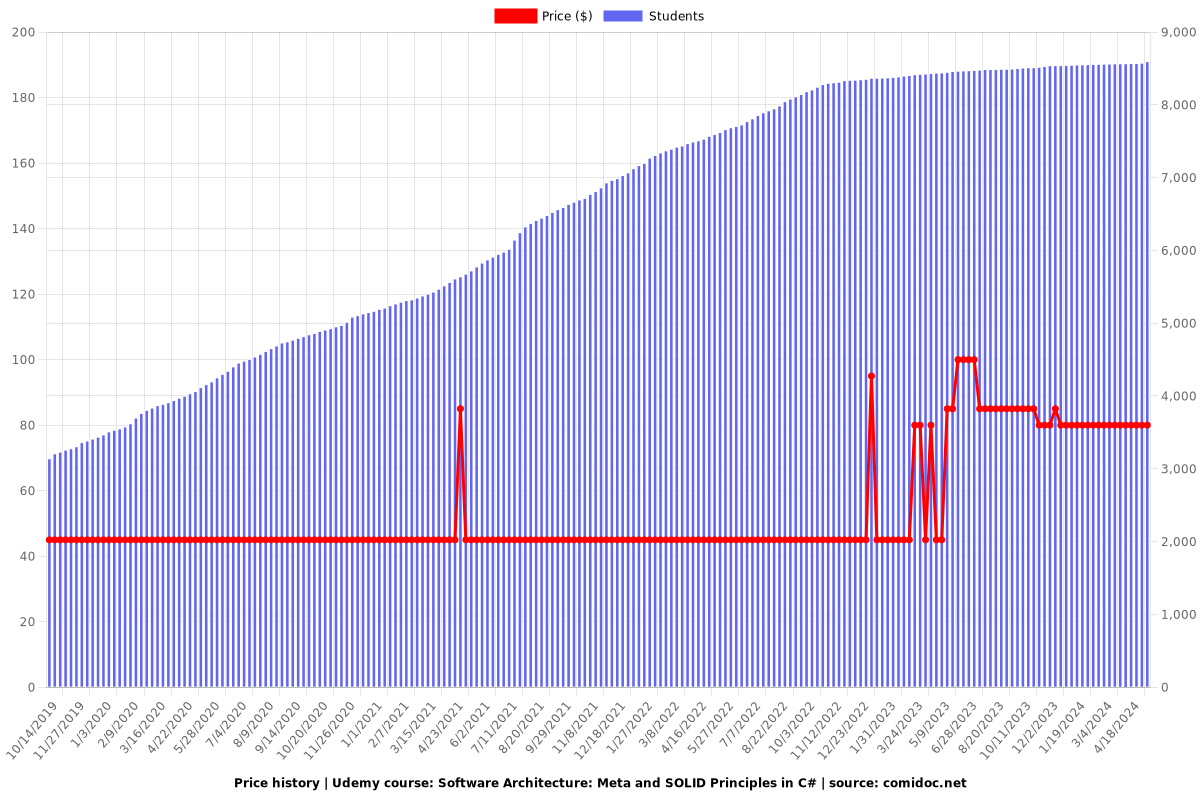Software Architecture: Meta and SOLID Principles in C#
Learn how to develop maintainable software systems applying Design Patterns based on Meta and SOLID Principles

What you will learn
Determine if a class has too many responsibilities
Apply SRP to make classes more granular
Determine the smell of duplication caused by OCP violation
Apply OCP to remove or prevent duplications
Make client's lives more enjoyable by applying ISP, making interfaces more granular
Determine LSP violations which break client's code
Apply LSP to come up with proper inheritance
Apply DIP to develop plugin architecture
Build your own simple IoC-Container
Build clean API in C#
I'm tired to list all the stuff you'll be able to do after this course )))
Why take this course?
SOLID is an acronym which stands for SRP, OCP, LSP, ISP and DIP. These five acronyms in their turn stand for:
Single Responsibility Principle
Open/Closed Principle
Liskov Substitution Principle
Interface Segregation Principle
Dependency Inversion Principle
In this course, you’ll learn how to apply meta and SOLID principles so that your application will live a long healthy life. It means you are going to learn how to write code of the high quality: readable, understandable and reliable.
Improve your knowledge in object-oriented programming
Understand the meta principles on which all the other development principles are based
Understand the symptoms of code defects
Learn the foundations of SOLID principles
Learn how to detect the violations of SOLID principles and how to fix the problems
Learn how meta principles and SOLID principles are related to each other and how to find the balance between them
Foundations of writing object-oriented code
Despite the fact that C# is a very rich on features language, it's very common to see poorly designed and implemented applications in a real world. Language by itself does not guarantee that the architecture of an application will be great. In order to design and build maintainable software, we need to understand the principles of software development. This video course is exactly about how to achieve clean and maintainable software.
You probably have already heard the following well-known statement: most code sucks. Well, this course is all about how to produce code which doesn't suck.
Owning skills of producing a well-designed and well-implemented types is the prerequisite for the other developers to treat you as a decent professional.
Content and Overview
This course is aimed at middle and senior developers. Solid experience in C# is required.
There are plenty of code examples throughout this course so that you will learn both theoretical and practical material.
Starting with SOLID principles we will go further to the meta-principles. Going through the SOLID principles, you’ll also learn about the related patterns. Then we will get to the problem of contradictions between different principles. You’ll learn about the relationships between SOLID principles and meta principles.
In general, you’ll learn in this course:
SRP
OCP
LSP
ISP
DIP
These are the SOLID principles. You’ll learn the background problems that can be solved by particular principle, you’ll see the demonstrations in code, you’ll learn the related patterns to every principle.
Learning DIP you’ll in addition learn what is Dependency Injection, Inversion of Control, IoC-Containers and what are the architectural implications of DI.
Here are other topics you’ll learn in the course:
DRY – don’t repeat yourself
KISS – keep it simple stupid
YAGNI – You Ain’t Gonna Need It
SoC – separation of concerns
CQS – command query separation
Law of Demeter
Principle of Least Astonishment
Information Hiding and Encapsulation
API Development Principles
Contradiction between SOLID and YAGNI
Contradiction between OCP and YAGNI
What is Architecture and Design
Teaching Approach
No fluff, no ranting, no beating the air. I respect your time. The course material is succinct, yet comprehensive. All important concepts are covered. Particularly important topics are covered in-depth.
Take this course, and you will be satisfied!
------------------------------------------------------------
Keywords related to the course:
Software Architecture
SOLID Principles Tutorial C#
SOLID Tutorial C#
Software Design
SOLID Principles
SRP, OCP, LSP, ISP, DIP
Screenshots




Our review
Charts
Price

Rating

Enrollment distribution
